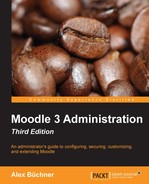Moodle has released a free app for iOS, Android and Windows Phone that allows users to interact with a Moodle system. At the time of writing this (app version 2.6) of the app supports key functionalities for participants to access certain course content, receive notifications, upload data, view grades, and interact with other users. Additional tools will be added in the very near future.
The Moodle app is an alternative to accessing Moodle via a web browser on a mobile device (a smartphone or tablet). However, it not only supports a subset of learner-centric features, but it also has the advantage that the app has been specifically designed for mobile usage and also supports offline content.
The process of enabling the Moodle app to interact with your Moodle site has been greatly simplified. Once the mobile web service has been enabled by navigating to Plugins | Web services | Mobile, a built-in service will be activated (refer to https://docs.moodle.org/en/Mobile_web_services).

Tip
It is highly recommended that you run your site over HTTPS when allowing mobile devices to access your site. The mobile app will always attempt to use a secure connection first. We covered the setting up of HTTPS in Chapter 11, Moodle Security and Privacy.
There is no requirement for the administrator to set up any functions or capabilities as these have already been predefined. To view the functions, check out the Built-in services section by going to Plugins | Web services | External services. When you click on the Functions link, you will be shown a list of all the functions that are used by the mobile web service. However, you cannot modify this list in any way. Additional functions will be added in the near future in sync with the newer versions of mobile apps.
You have also the option to Edit the Moodle mobile web service using the same settings as described in this section:

To check whether the Moodle mobile web service is working correctly, go and get your snazzy smartphone, download the Moodle Moodle app from the respective store (https://download.moodle.org/mobile), and enter Site URL, Username, and Password. If successful, you will see the landing page of your app:

Once web services for mobile devices have been enabled correctly, you also have the ability to customize the look and feel of the app (refer to Chapter 7, Moodle Look and Feel).
You may have already spotted the CSS field when you navigated to Plugins | Web services | Mobile earlier. You need to specify the URL of a CSS file (CSS, CSS2, or CSS3). While the file(s) can be stored anywhere accessible, it is recommended that the file is located inside your Moodle installation (usually as a custom theme). Once a style has been applied, the app of the user will change next time a learner opens the app on their mobile device. There is good documentation for mobile themes at https://docs.moodle.org/dev/Moodle_Mobile_Themes and https://docs.moodle.org/dev/Setting_up_your_development_environment_for_.
Moodle Mobile supports push notifications for different mobile platforms. As soon as web services for mobile devices are turned on, a new message output type will be available when you go to Plugins | Message outputs | Mobile notifications. The default values connect to the public Moodle messaging server. All you need to do is to request for an access key (via the link at the bottom). This requires that your site be registered with https://moodle.org/ (refer to the Finalizing the installation section in Chapter 1, Moodle Installation).

The public messaging server is a public Airnotifier system and, therefore, carries a degree of risk. It is possible to set up the infrastructure of your own notifications, which involves setting up a local Airnotifier server. You will find instructions and links to resources at https://docs.moodle.org/en/Mobile_app_notifications.
Here is a schematic overview of how push notifications work. APNS, WNS, and Google Cloud Messaging are their respective gateways to relay push notifications.

